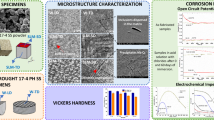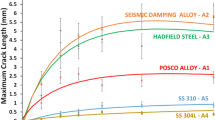Abstract
Rapid induction surface hardening of high-carbon steel with an initial martensitic microstructure can attain the very high-strength levels needed for lightweighting components such as shafts, gears, and bearings that are subjected to high operating stresses. Specimens of pearlitic and martensitic 0.6 wt pct C steels were heat-treated using a dilatometer to investigate the effects of prior microstructure, heating rates (5 to 500 °C/s), and austenitizing temperatures (850 to 1050 °C) on the transformation to austenite and subsequent transformation to martensite during helium quenching. Specimens were quenched from selected temperatures during heating to assess the initial cementite precipitates formed in martensite before transformation to austenite. Other specimens were isothermally held at the austenitizing temperature to assess cementite dissolution rates and austenite grain evolution. Higher heating rates increased the Ac1 and Ac3 temperatures and lowered the Ms temperatures. Martensitic prior microstructures resulted in lower Ms temperatures and lower hardness as compared to a pearlitic prior microstructure. Alloy content and the austenitizing temperature (900 or 1150 °C) utilized to provide the initial martensitic microstructure also influenced the transformation temperatures and the amount of retained austenite.
















Similar content being viewed by others
References
A. Lucas, A. De Paepe, H. Petitgand, C. Colin, L. Chapuis, and J. Artimez, Production of High Quality Formable Grades in an Ultra Short Annealing Processing Line, Luxemburg (2007)
R. Petrov, L. Kestens, W. Kaluba, and Y. Houbaert, Recrystallization and Austenite Formation in a Cold Rolled TRIP Steel during Ultra-Fast Heating, Steel Grips (2003), pp. 289–294
A. Reis, L. Bracke, R. Petrov, J. Kaluba, and L. Kestens, Grain Refinement and Texture Change in In-terstitial Free Steels After Severe Rolling and Ultra-Short Annealing. ISIJ Int., 2003, 43(8), p 1260–1267
R. Petrov, J. Sidor, and L. Kestens, Texture Formation in High Strength Low Alloy Steel Reheated with Ultrafast Heating Rates, Mater. Sci. Forum, 2012, 702-703, p 798–801
D. De Knijf, A. Puype, C. Föjer, and R. Petrov, The Influence of Ultra-Fast Annealing Prior to Quenching and Partitioning on the Microstructure and Mechanical Properties, Mater. Sci. Eng. A, 2015, 627, p 182–190
F. Castro Cerda, C. Goulas, I. Sabirov, S. Papaefthymiou, A. Monsalve, and R.H. Petrov, Microstructure, Texture and Mechanical Properties in a Low Carbon Steel After Ultrafast Heating, Mater. Sci. Eng. A, 2016, 672, p 108–120
A. Muljono, M. Ferry, and D.P. Dunne, Influence of Heating Rate on Anisothermal Recrystallization in Low and Ultra-Low Carbon Steels, Mater. Sci. Eng. A, 2001, 303, p 90–99
V. Massardier, A. Ngansop, D. Fabrège, S. Cazottes, and J. Merlin, Ultra-Rapid Intercritical Annealing to Improve Deep Drawability of Low-Carbon, Al-killed Steels, Metall. Mater. Trans. A, 2012, 43, p 2225–2236
Pei Li, Jun Li, Qingge Meng Wenbin Hua, and Xu Dechao, Effect of Heating Rate on Ferrite Recrystallization and Austenite Formation of Cold-Roll Dual Phase Steel, J. Alloys. Compd., 2013, 578, p 320–327
V. Massardier, A. Ngansop, D. Fabrège, J. Merlin, Microstructure and mechanical properties of low car-bon al-killed steels after ultra-rapid annealing cycles, in Proceedings of THERMEC, vol. 3 (2009)
A. Banis, E. Hernandez Duran, V. Bliznuk, I. Sabirov, R.H. Petrov, and S. Papaefthymiou, The Effect of Ultra-Fast Heating on the Microstructure, Grain Size and Texture Evolution of a Commercial Low-C, Medium-Mn DP Steel, Metals, 2019, 9(8), p 877. https://doi.org/10.3390/met9080877
E.D. Schmidt, E.B. Damm, and S. Sridhar, A Study of Diffusion- and Interface-Controlled Migration of the Austenite/Ferrite front During Austenitization of a Case-Hardenable Alloy Steel, Metall. Mater. Trans. A Phys. Metall. Mater. Sci., 2007, 38, p 698–715. https://doi.org/10.1007/s11661-007-9208-4
W. Kaluba, R. Taillard, and J. Foct, The Bainitic Mechanism of Austenite Formation During Rapid Heating, Acta Mater., 1998, 46, p 5917–5927
F. Cerda, I. Sabirov, C. Goulas, J. Sietsma, A. Monsalve, and R.H. Petrov, Austenite Formation in 0.2% C and 0.45% C Steels Under Conventional and Ultrafast Heating, Mater. Des., 2017, 116, p 448–460
S. Papaefthymiou, M. Bouzouni, and R.H. Petrov, Study of Carbide Dissolution and Austenite Formation During Ultra—Fast Heating in Medium Carbon Chromium Molybdenum Steel, Metals, 2018, 8, p 646
S. Papaefthymiou, C. Goulas, F.M. Cerda Castro, N. Geerlofs, and R.H. Petrov, The Effect of Heating Rate on the Microstructure of a Soft—Annealed Medium Carbon Steel, Steel Res. Int., 2017, 88, p 1700158
R. Cryderman, J. Speer, Microstructure and notched fracture resistance of 0.56% C steels after simulated induction hardening, in Proceedings of the 29th ASM Heat Treating Society Conference October 24-26, 2017, Columbus, Ohio, USA
K.D. Clarke, The Effect of Heating Rate and Microstructural Scale on Austenite Formation, Austenite Homogenization, and As-Quenched Microstructure in Three Induction Hardenable Steels. PhD thesis, Colorado School of Mines, Golden, Colorado (2008)
S. Papaefthymiou, A. Banis, M. Bouzouni, and R. Petrov, Effect of Ultra-Fast Heat Treatment on the Subsequent Formation of Mixed Martensitic/Bainitic Microstructure with Carbides in a CrMo Medium Carbon Steel, Metals, 2019, 9, p 312
J. Orlich, A. Rose, and P. Wiest, Atlas Zur Warmebehandlung der Stahle -Band 3, Zeit-Temperatur-Austenitisierung- Schaubilder, Verlag Stahleisen, M.B.G., Dusseldorf, Germany (1973)
V. Rudnev, G. Fett, A. Griebel, and J. Tartaglia, Principles of Induction Hardening and Inspection, Induction Hardening and Heat Treatment, ASM Metals Handbook, Vol 4c, ASM International, Cleveland, 2014
T. Eddir, R. Goldstein, E. Buchner, E. De Moor, and R. Cryderman, Influence of heating rates on temperature gradients in short time dilatometry testing, in Conference Proceedings—Thermal Processing in Motion, June 5-7, 2018, Spartanburg, South Carolina, USA
A. Banka, A. Senita, R. Goldstein, T. Eddir, E. Buchner, and R. Cryderman, Modeling of short time dilatometry testing of high carbon steels, in Conference Proceedings—Thermal Processing in Motion, June 5-7, 2018, Spartanburg, South Carolina, USA
C. Cayron, ARPGE: A Computer Program to Automatically Reconstruct the Parent Grains from Electron Backscatter Diffraction Data, J. Appl. Crystallogr., 2007, 40(6), p 1183–1188
G.F. Vander Voort and A. Roosz, Measurement of the Interlamellar Spacing of Pearlite, Metallography, 1984, 17(1), p 1–17
R. Cryderman, Austenite grain nucleation and growth after re-austenitizing pre-quenched 0.56% C steels, in Conference Proceedings of Thermal Processing in Motion, 2018, Spartanburg, SC, USA
R. Cryderman and T. Ballard, Short Time Austenitizing Effects on the Hardenability of 0.55 wt. pct. Carbon Steels, Metall. Res. Technol., 2018, 115, p 403
K.W. Andrews, JISI, 1965, 203, p 721
E.S. Rowland and S.R. Lyle, ASM Trans., 1946, 37, p 27
A. Vieweg, G. Ressel, P. Raninger, P. Prevedel, S. Marsoner, and R. Ebner, Comparing Fast Inductive Tempering and Conventional Tempering: Effects on Microstructure and Mechanical Properties. Metall. Res. Technol., 2018, 115, p 407
H.-S. Yang and H.K.D.H. Bhadeshia, Austenite Grain Size and the Martensite-Start Temperature, Scripta Mater., 2009, 60, p 493–495
S.-J. Lee and K.-S. Park, Prediction of Martensite Start Temperature in Alloy Steels with Different Grain Size, Metall. Trans. A, 2013, 44A, p 3423–3427
Acknowledgments
The authors acknowledge the support of the corporate sponsors of the Advanced Steel Processing and Products Research Center, an industry/university cooperative research center at the Colorado School of Mines. Special thanks to TimkenSteel and Nucor Steel for providing the test materials. We would also like to thank Cyril Cayron from Ecole Polytechnique Federale de Lausanne, Switzerland for his support with the crystallographic orientation simulations using ARPGE.
Author information
Authors and Affiliations
Corresponding author
Additional information
Publisher's Note
Springer Nature remains neutral with regard to jurisdictional claims in published maps and institutional affiliations.
Rights and permissions
About this article
Cite this article
Cryderman, R., Garrett, D., Schlittenhart, Z. et al. Effects of Rapid Induction Heating on Transformations in 0.6% C Steels. J. of Materi Eng and Perform 29, 3502–3515 (2020). https://doi.org/10.1007/s11665-020-04632-0
Received:
Revised:
Published:
Issue Date:
DOI: https://doi.org/10.1007/s11665-020-04632-0




